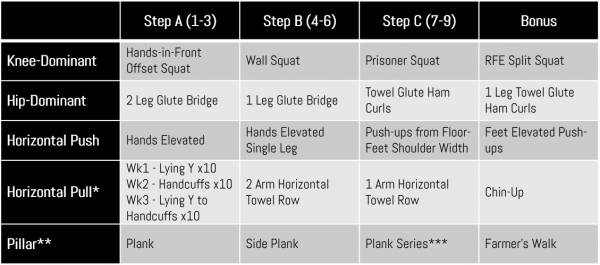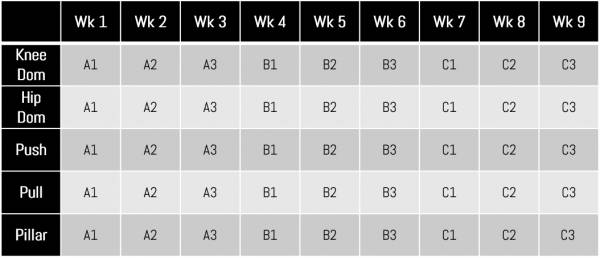Around the country, schools are investing more into their strength and conditioning programs. Any college football coach will tell you their first hire is the strength coach. This has trickled down to the high school level, where many programs have set strength and conditioning as a top priority for the safety and development of their young athletes. The need is overwhelming.
Around the country, schools are investing more into their strength and conditioning programs. Any college football coach will tell you their first hire is the strength coach. This has trickled down to the high school level, where many programs have set strength and conditioning as a top priority for the safety and development of their young athletes. The need is overwhelming. In this age of sedentary lifestyles and overspecialization, strength coaches help develop more physically resilient youth, while protecting them from poor movement quality that often leads to increased injury risk and broken down bodies.
But development that starts in high school is already too late. The problem is, most middle school coaches are already over-extended. Many are asked to coach three sports, and may have three teams per sport. There isn’t the budget for a dedicated strength coach, so the head coach ends up doing everything. They love their sports, but face challenges of extremely high athlete-to-coach ratios and insufficient facilities, and they may not have a background in performance training.
Most kids in our sedentary world have forgotten how to move. They have far more long-term potential and far less risk of injury if we begin correcting movements as early as possible. To address this situation, I developed what I call the Middle School Block 0 Program. It’s meant to help the overextended middle school coach by avoiding the problems of extra complication or unavailable resources. It is based largely on the structure created and promoted by Joe Kenn, the Director of Strength & Conditioning for the Carolina Panthers.
Before your kid sees the inside of a weight room, they need to learn to move well. [Photo credit: Emery Way on Flickr | CC BY 2.0]
Before the Block 0 Program Begins
Before middle school coaches can start this Block 0 program, they must invest time in teaching the structure and some basic skills. Each athlete must be put into lines, separated by at least three yards, and be given a spot that they are to always return to. This is the time to emphasize structure and commitment to being a “technician”. Explain to them that every team is preparing. What will separate them is their attention to detail. This is what I teach up front:
Athletic Position:
- Dan John’s Get-Up Circuit: This re-teaches how to fall and reprograms brain how to move efficiently.
- Jump Rope Progression: Regular x 10, right foot x 10, left foot x 10, alternating x 10, double unders x 10
- Push-up position plank (PUPP): Goal is 1 minute
Warm Up Circuit:
- Back to belly rolls: 2 left & right (hands only then legs only)
- Lateral Lunge: 5 per side with hands in front, feet set
- Inchworm x 8
- Feet over imaginary hurdles: 1 each side, 1 forward 1 back, with hands behind head
- Aquamans x 10
- Crawl forward 10 yards, all finish, then backward 10 yards
For a couple weeks, this is all you will teach. This period will be used to prepare athletes for the Block 0 structure I will discuss bellow.
The Middle School Block 0 Program
The roadblock I discovered when developing programs for our middle schools was that I had had to accommodate eighty 7th or 8th grade students under the tutelage of only two coaches. That effectively rules out weight rooms. For this program you need only a gym with some bleachers, chairs, or benches, and towels.
The program would focus on five different movement categories. Knee-dominant exercises are in the squat family. Hip-dominant exercises build the stability and musculature relevant to the hip hinge. For pushes and pulls, I decided to stick with horizontal movements to avoid issues with shoulder mobility and additional equipment. Finally, I added the pillar category to encompass all stability, crawls, carries, and rotational work.
Each exercise will be implemented for three weeks (called a “step”) before progressing to the next phase. Within each step, each week is associated with three tempos. The first week focuses on isometric holds for 15 seconds at the weak point. The second week, each movement has a six second command eccentric, or negative, followed by a ten second weak point isometric hold. In the third week of the step, there are ten total command repetitions with a 3threesecond eccentric, a one second weak point pause, and an explosive concentric. The structure is a circuit, going down the column of movement categories with four total rounds each session.
Once proficiency and execution is possible in all movements for these three tempo prescriptions, athletes are ready to move on to the next step (3-week period) where movements will be taught following the same 3-week tempo prescription.
The only exception to the tempo prescription is for pillar movements. These are always performed as isometric holds, progressing in increments of five seconds from 20 to 30 seconds over three weeks. Also, Step A of the Horizontal Pull is actually not a pull, but just a 3-week progression of Y-Handcuffs meant to attack postural muscles and begin offsetting our push dominant society.
Program Progressions
Remember, focus one week on each of the three tempos for each exercise: eccentric, eccentric-concentric, and concentric.

*Step 1 of Horizontal Pull does not follow the tempo prescriptions. Steps 2 & 3 do.
** Pillar never follows tempo prescriptions. All are isometric holds. Wk 1 20s; Wk 2 25s; Wk 3 30s.
*** Plank Series moves athletes from prone plank to side planks on each side.
Wk 1 5s @ ea; Wk 2 10s @ ea; Wk 3 15s @ ea. Remember do not progress until mastery of a step.
Tempo Formats:
- Tempo 1: Weakpoint Isometric Hold (x15s)
- Tempo 2: Eccentric (x6 seconds) to Isometric (x10s)
- Tempo 3: Eccentric (x4 seconds) to Concentric (x10)
Block 0 Possible Structures:
- Option 1: Monday, Wednesday, Friday: Warm-up, Bodyweight Strength Circuits;
- Tuesday, Thursday: Warm-up, J-Rope, Sprints, Games
- Option 2: Monday, Wednesday: Warm-up, Bodyweight Strength Circuits;
- Tuesday, Thursday…; Friday- Warm-up, Games
- Option 3: Monday: Sport Skills, J-Rope, Sprints; Wednesday, Friday-Games;
- Tuesday, Thursday: Warm-up, Bodyweight Strength Circuits
Movement Competency Checklist
Use this chart as a checklist to track when each athlete executes a movement, so that they may move on to the next step in the progression.

Notes: A, B, or C refers to which step in the movement progression you are on.
1, 2, or 3 refers to which week in the tempo prescriptions you are on.
Click here for downloadable, printer-friendly competency cards.
The Rules
- No athlete may complete a bad form rep. Until all reps at all three tempos in one step are mastered, there is no going to the next step. Seek quality execution.
- All athletes will have this card and need each level to be checked off as executed, before they may move on to the next.
What about those athletes that have not completed Step A, when it is time for Step B? That is where the Movement Competency Checklist becomes valuable. Print them on cardstock for each athlete to have while working, and then coaches can come by and check off competency as they see it. Using this card, you can know at a glance where each kid is in their progression, and what step and tempo they should be on. This allows kids to be on different steps in the movement progression at the same time. If you want to keep all the kids on the same level, that is great, too. You can simply add time or reps to continuously progress your more advanced kids. You will eventually be able to use this system to identify more advanced athletes and progress them on more advanced plans in a smaller group.
Fundamentals Come First
I delivered this program to our middle school coaches in a training session. At the end, one coach asked, “What do I tell my parents who want their kids lifting weights the day they start middle school?”
The best programs are phenomenal in the fundamentals, but that’s not what people want to hear. Too many parents seem to believe they are their kid’s sports agent. You have to educate parents on why this “slow-cook” method is best. Our kids have far less general physical preparation than any generation before. There are fewer opportunities for the free play and household work that once defined childhood and developed physical abilities. Most youth are extremely sedentary, immobile, and unable to execute fundamental movements. This must be addressed before any substantial developments can be made. If it’s not, then down the road athletes will have to be regressed and miss lifting at times more pertinent to their success. They will also be more likely to be injured and face gaps of time without training and persistent nagging effects.
It is far better to slowly progress and emphasize execution that will be a foundation for consistent improvement. Why would you bench press before you can do ten perfect push-ups? Back squatting is calculus. To back squat without being able to hold a 1-minute plank is a recipe for physical disaster. Advance them from arithmetic, to algebra, and so on. In this manner, athletes learn to correctly load movements so that their potential is far higher. Lastly, puberty is on your side. Youth must become masters at movement. In the process, they will get stronger quickly. It’s the beauty of their age; they will improve quickly.
So often we want to rush kids into advanced methods before they’re ready. The best gift you can give any athlete is a solid foundation and a commitment to consistency and habitual, correct execution. Rather than rushing middle schoolers into the weight room, consider this plan as a simple, safe and invaluable progression into the world of performance training.
More on preparing youth for sports and live:
Athletic Training for Pre-Adolescents
Improve your youth coaching techniques:
Plan for the Unplanned: How to Write a Program for Youth Athletes






